I have some data
library(data.table)
wide <- data.table(id=c("A","C","B"), var1=c(1,6,1), var2=c(2,6,5), size1=c(11,12,13), size2=c(10,12,10), flag=c(FALSE,TRUE,FALSE))
> wide
id var1 var2 size1 size2 flag
1: A 1 2 11 10 FALSE
2: C 6 6 12 12 TRUE
3: B 1 5 13 10 FALSE
which I would like to plot as bubble plots where id is ordered by var2, and bubbles are as follows:
ID A and B: var1 is plotted in size1 and "empty bubbles" and var2 is plotted in size2 with "filled" bubbles.
ID C is flagged because there is only one value (this is why var1=var2) and it should have a "filled bubble" of a different color.
I have tried this as follows:
cols <- c("v1"="blue", "v2"="red", "flags"="green")
shapes <- c("v1"=16, "v2"=21, "flags"=16)
p1 <- ggplot(data = wide, aes(x = reorder(id,var2))) + scale_size_continuous(range=c(5,15))
p1 <- p1 + geom_point(aes(size=size1, y = var1, color = "v1", shape = "v1"))
p1 <- p1 + geom_point(aes(size=size2, y = var2, color = "v2", shape = "v2", stroke=1.5))
p1 <- p1 + geom_point(data=subset(wide,flag), aes(size=size2[flag], y=var2[flag], color= "flags", shape="flags"))
p1 <- p1 + scale_color_manual(name = "test",
values = cols,
labels = c("v1", "v2", "flags"))
p1 <- p1 + scale_shape_manual(name = "test",
values = shapes,
labels = c("v1", "v2", "flags"))
which gives (in my theme)
but two questions remain:
- What happened to the order in the legend? I have followed the recipe of the bottom solution in Two geom_points add a legend but somehow the order does not match.
- How to get rid of the stroke around the green bubble and why is it there?
Overall, something appears to go wrong in matching shape and color.

